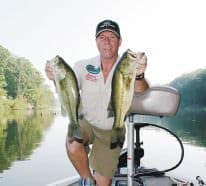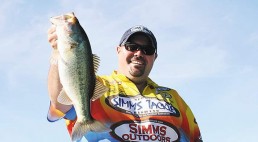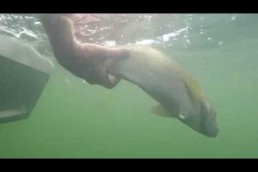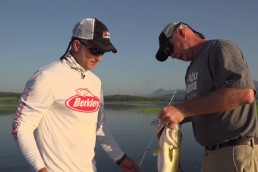Bass the ‘Panfish’ Way: Deadly Methods for when the Action Slows
SHARE THIS POST
When fishing pressure is low, weather is great, and the conditions are right, a wide variety of methods are effective for bass. In this scenario, fishing standard lures with traditional gear is best. This can also be a great time for larger offerings and more aggressive tactics. When things are off though, fewer options produce and fishing becomes tough.
As a full-time fishing pro and outdoors sports media member for over a decade, I’ve had to learn to shift gears in a hurry when things don’t go my way. Whether competing in a tournament, guiding a charter, or hosting a TV show, I’ve got to put quality bass in the boat with consistency, and the same is true for my pro staffers. One of the best methods we’ve found for catching bass when nothing else is working is through targeting bass the “panfish” way.
While bass are one of my favorites, I target a wide variety of species across a number of countries, and one of the greatest lessons anyone can ever learn is to never dismiss anything.
Crossing over
Tactics crossover well and we’ve used lures and methods for everything, from muskies to mackerel and snook to stripers to catch bass. I admit I prefer big game to smaller species, and, that outside of bass fishing I’m far more likely to chase “animals” like pike or marlin instead of little guys like panfish. But I encourage the staff guides working for me as well as all my lure company pro staffers to do a little of everything. This makes us better anglers—able to zig when everyone else zags.
What is the typical outcome? That’s simple: More and bigger bass get into our boats.
Panfish lures
Downsizing is nothing new, but few bassers take it as far as they can. Most “downsized” bass lures are not as small as artificial panfish baits, ones that are designed for crappies, goggle-eyes, yellow perch, bluegills and other sunfish. Living and working on the water for 200 days annually, I noticed over many years from talking to panfish anglers at the end of a tough day of bass fishing that they had done better. I also noticed when I occasionally spent a day after panfish that if it happened to be a tough day for anglers chasing bass, my clients and I had usually caught more and bigger bass.

Getting the other bass guys of my staff on board with the strategy of giving up some days of bass fishing here and there in order to target muskies, stripers, redfish, panfish, or others paid off in big dividends. Acquiring new information and learning different techniques to put to work on bass is key. You can’t expect to be good at something you never do; anglers who just throw some different lures and tackle in the boat for a rainy day are less likely to accomplish bass fishing goals as opposed to anglers who use it occasionally and practice different styles. When we downsized to panfish offerings when things got tough we did better with bass. Small spinnerbaits, crankbaits, topwaters, jigs, plastics, spoons and blade baits all can work well.
Are you enjoying this post?
You can be among the first to get the latest info on where to go, what to use and how to use it!
Panfish methods
The first thing to understand is that panfish lines are easier for bass to break, and extra care is required in fighting bass. In fact, play them as softly as possible unless they’re about to wrap around abrasive cover. Once away from heavy cover, take your time and let the rod and reel’s drag system do their job. Small hooks don’t require the boat rocking sets we’re so used to, and hard hook-sets can be counterproductive, resulting in bent steel and lost bass—again, this is just one of many things that only comes from time spent using this method and actually targeting panfish or at least targeting bass exactly like anglers do.
Two red-hot panfishing methods outside of the box that are deadly for bass are double-rig fishing and tail gunning. Double- rigs are just like the name sounds. Two lures are employed on one line to double the odds at catching bass. One three-way swivel or two-barrel swivels are attached to the main line with two droppers. Identical lures mimic schooling baitfish, while different ones quickly nail down patterns. In tail gunning, a leader runs out behind the main lure tied to the hook shank or as a dropper off the main line. A tiny lure trails behind, picking off straggling fish. The larger bait grabs attention while the trailer usually gets hammered. Or, a smaller offering up front creates the natural appearance of a smaller competitor chasing prey.
Panfish location
While bass and panfish location is often similar, since both species like to utilize structure and cover, and both feed on baitfish, crayfish, insects and similar prey items. But there are subtle differences. Probably the biggest difference my staffers and I have noticed in terms of angler focus is in the depth, or a lack thereof. Many panfish anglers, particularly those after goggle-eyes, bluegills and other sunfishes, will fish in extremely shallow water at times—inches of water actually—casting where few anglers do, picking up largemouths and smallmouths in spots that most miss.
Additionally, while flipping and pitching into brush is nothing new in the bass world, we seldom see bass anglers pitch into brush with a float. Tossing a fly or panfish jig into a brush pile on light line can work wonders; the float suspends the offering above most of the limbs and tempts bass holding higher in the pile that literally won’t strike anything else. Another option is using a 10- to 14-foot panfish pole to vertically suspend a lure for bass locating shallower when they won’t take a sinking lure dropped to the bottom.
Panfish equipment
Panfish gear is completely different than standard bass stuff, and even different from light bass gear employed for finesse fishing. Medium- to light-spinning rods with fast tips are replaced by ultra-lights with softer actions. These are critical for lightly setting small hooks, casting, properly presenting tiny lures and battling big bass on light line. The 4- to 6-pound-test line is typical, producing better action with small lures, and for decreased visibility for spooky fish in pressured waters. Small spinning reels must have quality silky-smooth drag systems to land big bass tempted with panfishing tackle and tactics.
Get out there
As we master more techniques, to come into contact with the wild creatures we love like the bass, we step further into their world and subsequently closer to “peace” in ours. In this seemingly warp-speed world we live in there becomes more and more of a need to slow down, especially for lovers of God’s great outdoors, and appreciate the magnificence of the wild creatures that call these magical places home, like bass. Get out there with family and friends or just all by yourself. Get out into the woods and onto the water for some quality time and restoration for the soul, and into this natural world to feel true life surge through you.
Colby Simms is a professional fisherman, media personality, guide and owner of Colby Simms Outdoors Group. He runs a guide service, sells tackle and books on guided fishing and hunting trips. Contact: colbysimmsoutdoors@hotmail.com, 618-521-0526, 573-358-5948 or facebook.com/ColbySimmsOutdoors/.
MWO
SHARE THIS POST
Did you enjoy this post?
You can be among the first to get the latest info on where to go, what to use and how to use it!
Colby Simms
Colby Simms is a professional fisherman, media personality, guide and owner of Colby Simms Outdoors Group. He runs a guide service booking guided fishing and hunting trips, and sells tackle. Contact him at colbysimmsoutdoors@hotmail.com, Facebook @ColbySimmsOutdoors and @ColbySimmsSportFishingPro, or 618-521-0526 or 573-358-5948.



